Genre: Shmup Developer: Telenet Publisher: Renovation Players: 1 Released: 1990
Back in the early 1990s, the Genesis was riding on a wave of growing popularity. Part of that wave, was an influx of games in the shmup (shoot-’em-up) genre. For a couple of years, the Genesis was on the receiving end of shmup after shmup. Some were average, some were great, and some were so questionable, that history would rather forget they existed. Where does Whip Rush reside? Read on.
In the year 2222 AD, a trio of exploration ships left the Earth in hopes of finding a new planet to populate. Earth was getting a bit crowded, and some new territory was needed. After five years, the ships radioed Earth, and said they had found a suitable planet called Voltegeus. But, like all good space explorations, contact was lost with the ships as they were approaching the planet. Fast forward a week, and there’s a big alien ship that has appeared near Mars, and it’s attacking Earth. That’s where you and your lone ship come into play, and you’ll have to fight through seven levels to keep Earth from being turned into a buffet for the invading forces.
Right off the bat, Whip Rush won’t be wowing anyone with its graphics. Put next to the likes of Bio-Hazard Battle and Thunder Force IV, this game looks a bit rough. However, it’s not an ugly game at all. In fact, rather than try to build up realistic visuals, Whip Rush steps off to the side, and instead goes for a style that’s a cross between cartoony and realistic. By “cartoony” I mean there’s shading on the enemies, backgrounds, and such, with designs that look simpler and not so detail oriented. It even appears like the designers tried to incorporate a little bit of “cutesy” into the game’s visual style. The stages themselves have variety in terms of design, ranging from tree lined rivers, to clouds, and alien ships. They also have nice amounts of parallax scrolling going on, giving them a good sense of depth. They don’t take you to worlds you haven’t already seen before, but they do a good job conveying the worlds they’re trying to portray. So overall, while the graphics don’t have any wild Konami/Treasure effects, they achieve their style well and come off looking nice.
So, the graphics won’t exactly floor you, but what about the sound? The sound effects aren’t the best you’ll hear from the Genesis, but they aren’t grating, and they fit well with the somewhat cartoony style of the visuals. So in that sense, they’re fine. However, musically, this game is quite nice. The music is fitting, well composed, and at times, very catchy. Each track fits with the background you’re fighting on, be it the opening, inside a cave, going around a huge battleship, or approaching your final battle. You can tell someone spent some time trying to get the music to fit with the stage and game progression, and not just making songs to stick anywhere in the game.
With the gameplay, you get a well-rounded balance of weapons. Besides your starting, basic weapon, there’s a straight laser, missiles, and a fireball. Each weapon can be powered up three times, and each has its advantages and disadvantages. For example, the laser can only fire forward, but it packs quite the wallop. The missiles aren’t as powerful and also only fire forward for the most part, but they have some limited tracking abilities, and can put some firepower behind your ship once they get powered up. The fireball is the weakest weapon of the three, but it can be fired 360 degrees around your ship.
These weapons aren’t all you get. You can also pick up a pair of satellite guns to increase your firepower, and you can even use these satellites to attack enemies by rotating their positions around your ship and sending them rocketing into enemies. You’ll need all these weapons, as the stages offer up enemies that come at you from all sides. The stages themselves also feature obstacles that must be avoided, and tight spaces to carefully maneuver through. So it’s not just the enemies trying to kill you, but the landscape around you as well.
Normally, this is where I would go into the things that got pretty messed up in the game. But here’s the interesting part about Whip Rush… it doesn’t do anything particularly wrong. There are no glaring spots of bad coding or glitches. The controls are crisp, the hit detection is good, the weapons each serve a purpose, and the stages have good designs. It simply doesn’t have a truly horrible area. What it does have though, are graphics that aren’t pushing many limits, and a difficulty curve that’s not quite as challenging as it could be. I suppose if there was a real down side to the game, it’s that it follows the template for shmups of its time a bit too closely. But even this is countered a bit by how you can use the weapon satellites to attack by ramming them into enemies, and the rather odd (and sometimes humorous-looking) bosses that rely on more than just bullets to kill you.
So where do we stand with Whip Rush? As I said, it doesn’t have any glaring faults, but it does suffer from some of the “me too” syndrome that was building up around the time of its release. The graphics are a bit simple, and the levels aren’t anything new, but the music is great, the gameplay is solid with some originality added to the weapon satellites, the stages themselves are designed well, and over all, it’s a fun game. It even won an award back in its day. As such, I can’t call the game average, nor can I call it the best thing on the Genesis. What I can say, is that if you enjoy shmups, give this underdog a try. Its few minor shortcomings don’t overshadow what it ultimately is… a good game.
SCORE: 8 out of 10

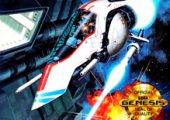
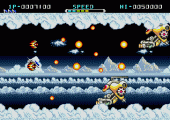
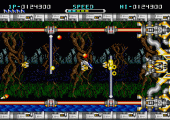
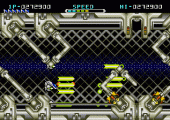
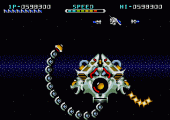
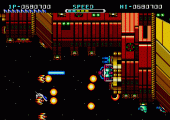
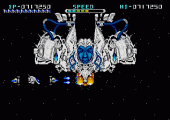
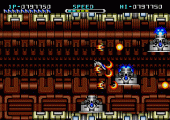
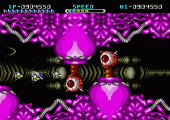
A true classic.